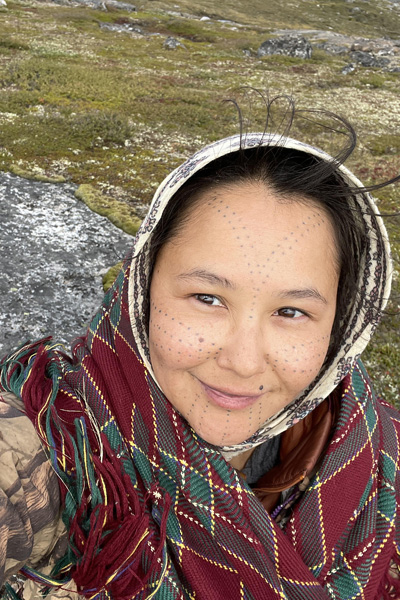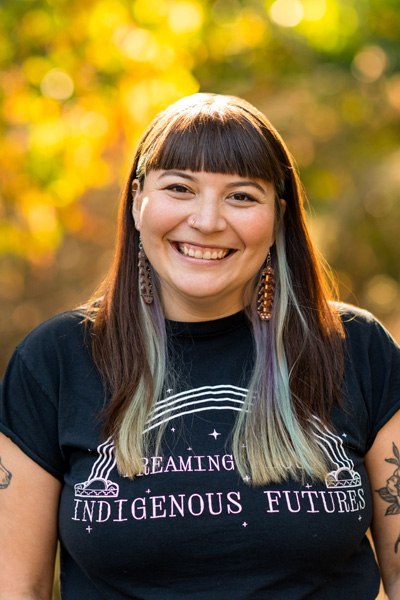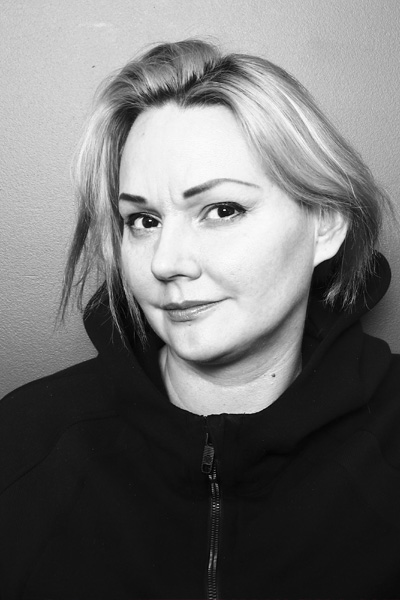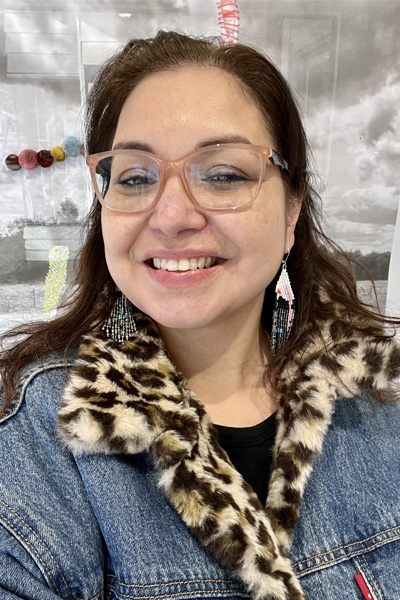Keynote Speakers 2024
Kevin McKenzie

Kevin McKenzie is Cree/Métis, born in Regina, Saskatchewan. He is a member of the Cowessess First Nation of Saskatchewan,Treaty 4. He holds a BFA and an MFA from the University of Regina.
During his 30-year art practice, McKenzie has exhibited nationally and internationally, notable exhibitions include Changing Hands: Art Without Reservation II, Museum of Arts and Design, New York. He also participated in Don’t Stop Me Now, National Gallery of Canada. If We Never Met, Pataka Art Gallery Museum, New Zealand. His work is represented in Transformer: Native Art in Light and Sound, at the National Museum of the American Indian, Smithsonian Institute, New York, November 2017- Jan. 2019. His work was selected as the inaugural exhibition titled ASAP at Urban Shaman Contemporary Aboriginal Art Satellite Gallery Santa Fe, via Vital Spaces Santa Fe, NM USA.
McKenzie’s artwork is represented in the collections of; the National Gallery of Canada, the MacKenzie Art Gallery, Indigenous and Northern Affairs Canada, Manitoba Hydro Corporation, the President’s Art Collection University of Regina, First Nations University of Canada, Comox Valley Art Gallery, the Saskatchewan Arts Board and the Dunlop Art Gallery. He has a permanent public sculpture in Whistler B.C. commissioned by VANOC Cultural Olympiad 2010. In 2022 he was commissioned by the Presidents Office at Brandon University to produce a public sculpture dedicated to Truth and Reconciliation titled “Healing Together”.
McKenzie lives in Brandon, Manitoba, he works at Brandon University as an instructor at Ishkaatbatens Waasa Gaa Inaabetag (IWGI) Department of Visual Art.
Heather Igloliorte

Dr. Heather Igloliorte, an Inuk-Newfoundlander from Nunatsiavut, is the Canada Excellence Research Chair in Decolonial and Transformational Indigenous Art Practices at the University of Victoria, BC, where she is a Professor in the Visual Arts Department. There, Heather directs the nation-wide Inuit Futures in Arts Leadership Project (2018-2025). Heather has been a curator since 2005 and has worked on more than thirty curatorial projects including nationally and internationally touring exhibitions, permanent collection exhibits, festivals, and public art installations. Her curatorial work has recognized by The Hnatyshyn Foundation with the Award for Curatorial Excellence in Contemporary Art (2021). Igloliorte has served on many advisories, councils and jurys. She is the current president of the board of the Inuit Art Foundation, and was the first Indigenous person in Canada to be awarded a Royal Canadian Academy of Arts Medal for her service to Indigenous art and artists, also in 2021.
Daina Warren

From 2000 to 2002, between her diploma and BFA studies at Emily Carr University, Warren was a curator-in-residence at grunt gallery in Vancouver through Canada Council’s Assistance to Aboriginal Curators for Residencies in the Visual Arts program. This led to a permanent position with grunt, where she remained as Associate Curator and Administrator until 2008. During this same period, Warren served for four years as Curatorial Assistant and Arts Administrator with the LIVE Biennale of Performance Art in Vancouver.
In 2010 and 2011, she worked as the Canada Council Aboriginal Curatorial Resident at the National Gallery of Canada in Ontario. There, she curated the group exhibition Don’t Stop Me Now. Other exhibitions of note include If These Walls Could Talk and Contains Animal Byproducts!, created for the CODE Screen 2010 Vancouver Olympics project.
From 2011 to 2022 she worked as Director and Curator at Urban Shaman Contemporary Aboriginal Art in Winnipeg, Manitoba. During her time with Urban Shaman, she mentored a half dozen individuals in arts programming development, arts administration, grant writing, installation and preparatory work.
Warren has co-instructed courses with Dr. Jessica Jacobson-Konefall at both the University of Manitoba and the University of Winnipeg. She has served as a grant jury assessor for organizations ranging from Emily Carr University and the City of Vancouver to the Ontario Arts Council, British Columbia Arts Council and Canada Council for the Arts. She has given curatorial talks and been an invited speaker at institutions across the country as well as internationally.
In 2015, Warren was awarded the Emily Award from Emily Carr University. That same year, she was selected as one of six Indigenous women curators as part of the Canada Council for the Arts Delegation to participate in the International First Nations Curators Exchange in Australia (2015), New Zealand (2016) and Canada (2017). In 2018, she won the Hnatyshyn Foundation Award for Curatorial Excellency. In 2020, she participated in the 22nd Biennale of Sydney, NIRIN, on invitation from Australia Council for the Arts’ Visiting International Curators program. In 2022, Daina received the Manitoba Arts Award of Distinction, which is awarded biannually in recognition of the highest level of artistic excellence and contribution to the development of the arts in Manitoba. She is currently the Executive Director, Indigenous Initiatives at Emily Carr University of Art & Design, and heading the Aboriginal Gathering Place for ECU.
Artists-in-Residence 2024
asinnajaq

asinnajaq is from Inukjuak, Nunavik and lives in Tiohtià:ke (Montreal). Her work includes photography, filmmaking, writing and curating. She co-created Tillitarniit a three day festival celebrating Inuit art and artists. Asinnajaq wrote and directed Three Thousand (2017) a short sci-fi documentary. She co-curated Isuma’s show in the ‘Canadian’ pavilion at the 58th Venice. In 2020 asinnajaq was long listed for the Sobey Art Award. She co-curated the inaugural exhibition INUA at the Qaumajuq. Asinnajaq programmed the Flaherty NYC 2022 fall program Let’s all be lichen. In their work, asinnajaq is interested in sharing tools for navigating life’s journey.
Taylor Baptiste

Taylor Baptiste is an interdisciplinary artist from the Osoyoos Indian Band of the Okanagan Nation. She draws upon her upbringing in Nk’mip – a field of sagebrush and wild roses nestled between the mountains and Osoyoos Lake on the Osoyoos Indian Band reservation. Raised by Richard and Colleen Baptiste, her art practice is deeply rooted in her family, community and ancestral history. Moreover, she incorporates elements of Syilx storytelling and epistemologies, reflecting a connection to the land and waters of the Okanagan.
Taylor sculpturally blends Okanagan land-based materials and Syilx traditional practices with contemporary mediums and modes of making; working with materials ranging from ochre pigment, buckskin, rocks, beadwork, sinew and ready-made materials. While sculpture serves as her primary mode of expression, Taylor’s artistic repertoire also encompasses digital illustration, painting, photography, and most recently, film and projection.
In May of 2024, Taylor will be graduating with a Bachelor of Fine Arts from Emily Carr University of Art & Design. She now resides with her husband in the traditional territory of xwməθkwəy̓ əm (Musqueam), colonially known as Vancouver.
Mariel Belanger

Mariel Belanger is a PhD student at Queens University in Cultural Studies researching ethnographic historical documents and recordings to map the archives for family specific song, story and lived experiences of the Syilx people at the Head of the Lake. Mariel’s research centre’s identity through the lens of Indigenous ways of knowing and being in the world, customary law, Indigenous feminism, smi7may7 Syilx performance theory, intersectionality, the effects of being ‘half’ and exploring how cultural identity is rebuilt through oral history and performance practice. Mariel’s MFA thesis “The Earth Re:Claimed Her. A continuing study of Blood Memory, Embodied Story Practice and Personal Governance” won her an SSHRC scholarship and was the foundation to bringing new histories to light. Mariel has travelled to Chile from Temuco to Socorama demonstrating a sqilxw-centric land-based visitor protocol and performing how colonial violence still affects the bodies of Indigenous women through her performance Illegal: Let Us Live co-authored by the late Dr. Greg Younging. In 2022, Mariel won a CGS SSHRC Doctoral Scholarship and the Teyonkwayenawá:kon – Queens University Graduate Scholarship. Mariel’s writing can be found in the chapter “Sqilxw Woman: She Brings Bundles” in the forthcoming book Unsettling Education: Decolonizing and Indigenizing the Land, “Respons(A)bility: Weaving Words of Responsibility Through Story” in the online journal Revue Percees, “stəqpistns iʔ pqlqin / kihew omīkwan Eagle Feather” in New Directions for Theorizing in Qualitative Inquiry, “Experiencing Resonance as a Practice of Ritual Engagement” co-authored chapter in Research and Reconciliation, and alt.Theatre Cultural Diversity and the Stage Magazine Vol 14.1 through 14.3 as guest curator and writer. www.sqilxw.com
Cori Derickson

Cori Derickson is an interdisciplinary Syilx artist. She has studied at the Enowkin Centre and completed her Bachelor of Fine Arts Degree and Master of Arts degree at UBC (Okanagan). She published her book Stimtema:13 Grandmother Moons from her graduate work following in the footsteps of her Great Great Grandmother Mourning Dove the first published Native American of North America. Her works are inspired by her Syilx – Okanagan Indigenous traditional family knowledge and history. Her interdisciplinary practice includes that of dance, sculpture, music, song, writing, animation and production of multi-mediaworks. Cori has performed her beautiful, artistic and spiritually moving dances both locally and internationally.
Most recently she has performed her songs with the Okanagan Symphony Orchestra the first time since pre-pandemic whereby she curated the collaborative production Tmixw – Spirit Chief Names the Animal People. Cori currently teaches at Okanagan College and the Enowkin Centre. This summer watch for her collaborative show with Kama? Collective entitled Syilx Ways of Knowing: Squilxcawt at Vernon Public Art Gallery
Victoria Jaenig
Victoria “Tori” Jaenig is a three-time award winning Indigenous Storyteller, Media Artist and Producer and has produced over 30 short films, music videos, documentaries and informational videos. She has curated and exhibited her body of works in group and solo exhibitions or festivals for over twenty years. Victoria toured parts of Europe, Western Canada and Northwestern USA as a dance and theater performer with Secwepemc Theatre, Rainbow Productions and Nak’ulamen Performance Collective with productions she performed in, wrote, directed, and/ or produced. This experience has led her to be a mentor and instructor of Indigenous Storytelling and Performance, Media Arts, Marketing classes and Portfolio Development as part of the National Indigenous Professional Artist Training (NIPAT) program at the Internationally renown Indigenous Post Secondary institute, En’owkin Centre.
Peter Morin

Peter Morin is a grandson of Tahltan Ancestor Artists. Morin’s artistic offerings can be organized around four themes: articulating Land/Knowing, articulating Indigenous Grief/Loss, articulating Community Knowing, and understanding the Creative Agency/Power of the Indigenous body. The work takes place in galleries, in community, in collaboration, and on the land. All of the work is informed by dreams, Ancestors, Family members, and performance art as a research methodology. Initially trained in lithography, Morin’s 20 years of artistic practice moves from printmaking to poetry to button blanket making to installation drum making to bead work to performance art. Throughout his 20 year exhibition and making history, Morin has focused upon his matrilineal inheritances in homage to the matriarchal structuring of the Tahltan Nation, and prioritizes Cross-Ancestral collaborations as a strategy for interrogating and dismantling the colonialism. Morin was longlisted for the Brink and Sobey Awards, in 2013 and 2014, respectively. In 2016, Morin received the Hnatyshyn Foundation Award for Outstanding Achievement by a Canadian Mid-Career Artist. Morin is working as the Graduate Program Director of the Interdisciplinary Master’s in Art, Media and Design program (IAMD) at OCADU, and the Advisor to the VP Academic on Indigenous Knowledge, Practice and Production. Morin currently holds a tenured appointment in the Faculty of Arts at the Ontario College of Art and Design University in Toronto. Peter is the son of Janelle Creyke (Crow Clan, Tahltan Nation) and Pierre Morin (French Canadian).
Nicole Neidhardt

Nicole Neidhardt is a Diné (Navajo) multi-disciplinary artist and illustrator originally from Santa Fe, NM. She received her MFA from OCAD University in Toronto, Ontario, and a BFA with a business minor from the University of Victoria. Nicole’s Diné identity is the heart of her practice which encompasses illustration, installation, murals, and Indigenous Futurisms. Her multi-disciplinary practice centers and uplifts Indigenous worldviews and voices in order to contribute to strong and vibrant Indigenous futures. She has illustrated the books, Circle of Love, Braiding Sweetgrass for Young Adults, and What Your Ribbon Skirt Means to Me: Deb Haaland’s Historic Inauguration.
Krystle Silverfox

Krystle Silverfox is a member of Selkirk First Nation (Wolf Clan), and interdisciplinary visual artist. She currently lives and works on the territory of the Kwanlin Dün First Nation and Ta’an Kwach’an Council (Whitehorse, Yukon). Silverfox holds both a BFA in Visual Art (2015); a BA in Gender, Race, Sexuality and Social Justice from UBC (2013); also an MFA in Interdisciplinary studies from Simon Fraser University (2019). Her artistic practice explores different materials, methodologies, and symbols to create conceptual works. Krystle Silverfox is inspired by Indigenous feminism, trans- nationalism, decolonialism, activism, and lived experience.
Michelle Sound

Michelle Sound is a Cree and Métis artist and mother. She is a member of Wapsewsipi Swan River First Nation in Treaty 8 Territory, Northern Alberta and she was born and raised on the unceded and ancestral home territories of the xʷməθkwəy̓əm (Musqueam), Skwxwú7mesh (Squamish) and Səl̓ílwətaʔ/Selilwitulh (Tsleil-Waututh) Nations. She holds a Bachelor of Fine Arts from Simon Fraser University, School for the Contemporary Arts, and a Master of Applied Arts from Emily Carr University Art + Design. Michelle is currently an Indigenous Advisor at Douglas College. She is a multidisciplinary visual artist and her art practice includes a variety of mediums including photo based work, textiles, painting and Indigenous material practices. Her artwork often explores her Cree and Métis identity from a personal experience rooted in family, place and history.
She works with traditional and contemporary materials and techniques to explore maternal labour, identity, cultural knowledge, and cultural inheritances. Public art pieces include a utility box art wrap (City of Vancouver), street banners (City of New Westminster) printed Transit shelter mural and a painted mural at Ociciwan Art Centre (Edmonton)She has had recent solo exhibitions at Neutral Ground ARC (Regina), Daphne Art Centre (Montréal), Alternator (Kelowna), Gallery 101 (Ottawa), Burrard Arts Foundation, and Seymour Art Gallery (Vancouver).
Marika Swan

Marika Echachis Swan / ƛ̓upinup is a mother and artist of mixed Tla-o-qui-aht, Scottish and Irish descent. Her main creative practice is woodblock printmaking, often layered with other visual arts techniques such as carving, stencil and photography. With no formal arts training, Marika has developed her own contemporary take on the iconic Nuu-chah-nulth aesthetic through mentorship, study and fearless experimentation. Her evocative work is a voice for Nuu-chah-nulth cultural values from an uncompromising, feminist perspective.
Currently based out of her home territory of Tla-o-qui-aht (surrounding Tofino, BC), Marika balances her creative practice with various community arts projects. For several years, Marika was working closely with the development of the Carving on the Edge Festival creating an elevated platform to celebrate both the traditional and contemporary coastal carving arts. Through her work with the festival, Marika began developing a community led research project called The Nuu-chah-nulth Living Archive, locating and documenting the vast bodies of ancestral belongings and materials from her community that are now held in various museums and institutions all over the world. In it’s current evolution, it hosts information on hundreds of belongings, audio recordings, archival photos and songs on a private database for Nuu-chah-nulth community members, creating a virtual space for shared ownership and knowledge sharing. Through this project, Marika is actively creating deeper connections with local culture keepers to stimulate community discussion and cultural revitalization. The Nuu-chah-nulth Living Archive works in partnership with the Tla-o-qui-aht Repatriation Committee – of which Marika is a founding member – as well as various other local cultural education initiatives.
Through engaging with these ancestral treasures, Marika has studied traditional Tla-o-qui-aht form and style extensively. Following in the wake of artists like her father Joe David that took such sincere care in reviving the purity and perfection of classic traditional form, Marika continues to push the art form into new spaces. Still rooted in Nuu-chah-nulth world views, her work speaks directly to the stories that are relevant to her community now.
Justine Woods

Justine Woods (she/her) is a garment artist, creative scholar, and educator. She is a Doctoral Candidate in the Media and Design Innovation practice-based PhD program at Toronto Metropolitan University. Justine’s research and design practice centres Indigenous fashion and garment-making as practice-based methods of inquiry toward re-stitching alternative worlds that prioritize Indigenous resurgence and liberation. Born and raised in Tiny, Ontario, Justine is a registered member of the Métis Nation of Ontario from the Georgian Bay Métis community (St. Onge and Berger-Beaudoin families). Her Ancestors come from Drummond Island, in what is now known as Michigan, and were relocated in 1828 to Penetanguishene, Ontario where they built diasporic roots with their kin and community that continue to hold strong to this present day.
